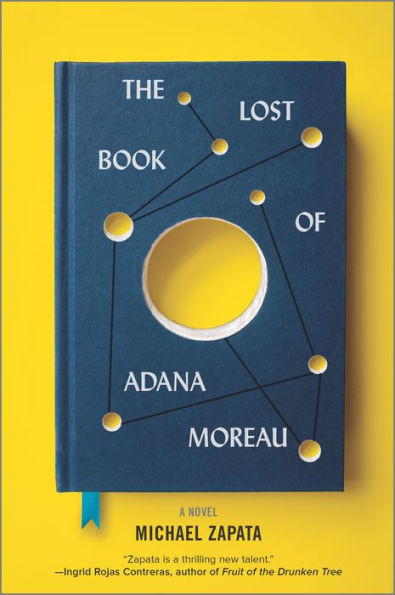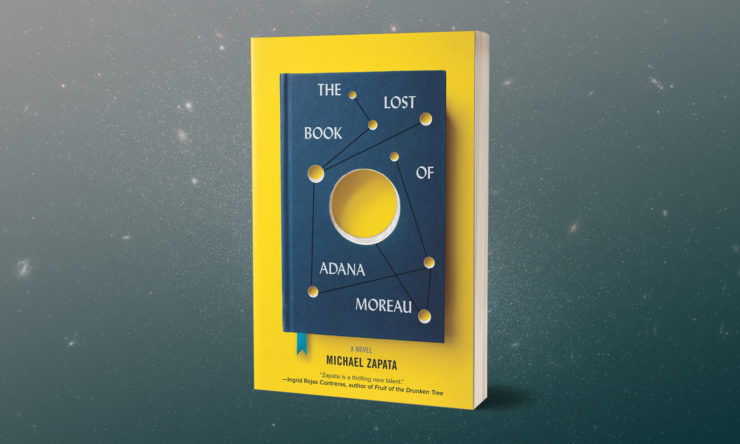One of the most difficult tasks for any fiction writer telling a story about the life of a fictional writer is coming up with believable fictional stories to fit within the larger work. If the plot of a book involves a critically acclaimed novel and the summary of that novel doesn’t ring true, the whole structure of the work begins to collapse. Some authors have taken this to its logical extension and published books nominally written by fictional characters they’ve created. It’s an expansive club, ranging from Rainbow Rowell to Antoine Volodine.
Michael Zapata doesn’t go quite that far in inhabiting the work of the fictional author who gives his novel The Lost Book of Adana Moreau its title, but if he ever opts to do so, I’ll happily sit down and read it. Zapata’s novel is set in two parallel time periods—one in the early years of the 21st century, one in the early decades of the 20th. From the outset, it’s apparent that they’ll connect in some way, but the precise nature of how is one of the engines that drives this book. And, like Paul La Farge’s 2017 novel The Night Ocean, Zapata’s book is both about genre fiction and potentially an example of it.
Adana Moreau is a Dominican immigrant living in New Orleans in the years leading up to the Great Depression. Zapata’s evocation of New Orleans at this point in history is deeply lived-in, offering a vision of the city with strongly felt connections to the Caribbean. Also present in the narrative, via news clippings that Adana reads, is the explorer Percy Fawcett and his quest for the City of Z. These early chapters read as though they were informed by Ned Sublette’s The World That Made New Orleans and David Grann’s The Lost City of Z, and if you think that sounds like a compelling combination, you are not wrong.
Buy the Book


The Lost Book of Adana Moreau
Eventually, Adana begins writing a science fiction novel of her own, called Lost City. It’s about a young woman from Santo Domingo who survives an apocalyptic event, only to come into contact with zombies and gateways to parallel Earths. The overall effect is like a feminist Latin American version of Michael Moorcock’s A Nomad of the Time Streams—though in Zapata’s novel, Moreau predated Moorcock by several decades. Her novel is published to acclaim, and she begins work on a sequel—“A Model Earth, in which the city of New Orleans is a spaceship and in which there are innumerable Earths in parallel universes.” But she falls ill suddenly, and opts to destroy the manuscript of A Model Earth before her death.
Except that, 70-odd years later, a Chicago man named Saul Drower discovers a manuscript that appears to be Moreau’s novel in the papers of his late grandfather. The manuscript had been intended to be sent to Maxwell Moreau, Adana’s son, who has grown into a scientist whose specialty is parallel universes. Maxwell appears to have relocated back to New Orleans, and Saul and his journalist friend Javier—both of whom had tender bonds with Saul’s grandfather—decide to seek him out. And then Katrina hits New Orleans, a real-life apocalyptic event that parallels the fictional apocalypses in Adana’s novel and in the science fiction that Saul enjoys.
The existence of a theoretically impossible book, and the use of parallel universes as a running motif in the novel, create a sense of ambiguity as to whether or not this novel will take a turn for the uncanny. That’s but one of several motifs that Zapata neatly weaves in and out of the storyline; there’s also the way that the narrative sometimes pauses so that another character can tell a story from their life. The tellers of these tales range from the Katrina survivors that Saul and Javier encounter to the doctor who treated Adana near the end of her life. Storytelling as a whole, too, is both a device in this book and something that’s key to the plot.
At one point early in the novel, Saul muses on the idea of parallel Earths: “the only real difference between one universe and another was merely a question of language, a question of what if?”
This echoes an observation Adana makes as she works to create her own fictional universe:
But through unreality, the Dominicana thought, they understood at least one important thing: that people could be other people, cities could be other cities, and worlds could be other worlds.
It’s a thought-provoking examination of stories and worlds, and one which rarely goes in the direction you’d expect. It is, curiously, a very male novel—for all that Adana is a looming presence over the entire work, she’s also the most significant female character by a long shot. And while this seems by design, the idea of creating a female writer who anticipates several decades of science fiction and then leaving her legacy in entirely male hands creates a slight cognitive dissonance. But overall, The Lost Book of Adana Moreau is a thought-provoking literary mystery, and its title character a welcome addition to the canon of fictional science fiction writers.
The Lost Book of Adana Moreau is available from Hanover Square Press.
 Tobias Carroll is the managing editor of Vol.1 Brooklyn. He is the author of the short story collection Transitory (Civil Coping Mechanisms) and the novel Reel (Rare Bird Books).
Tobias Carroll is the managing editor of Vol.1 Brooklyn. He is the author of the short story collection Transitory (Civil Coping Mechanisms) and the novel Reel (Rare Bird Books).










